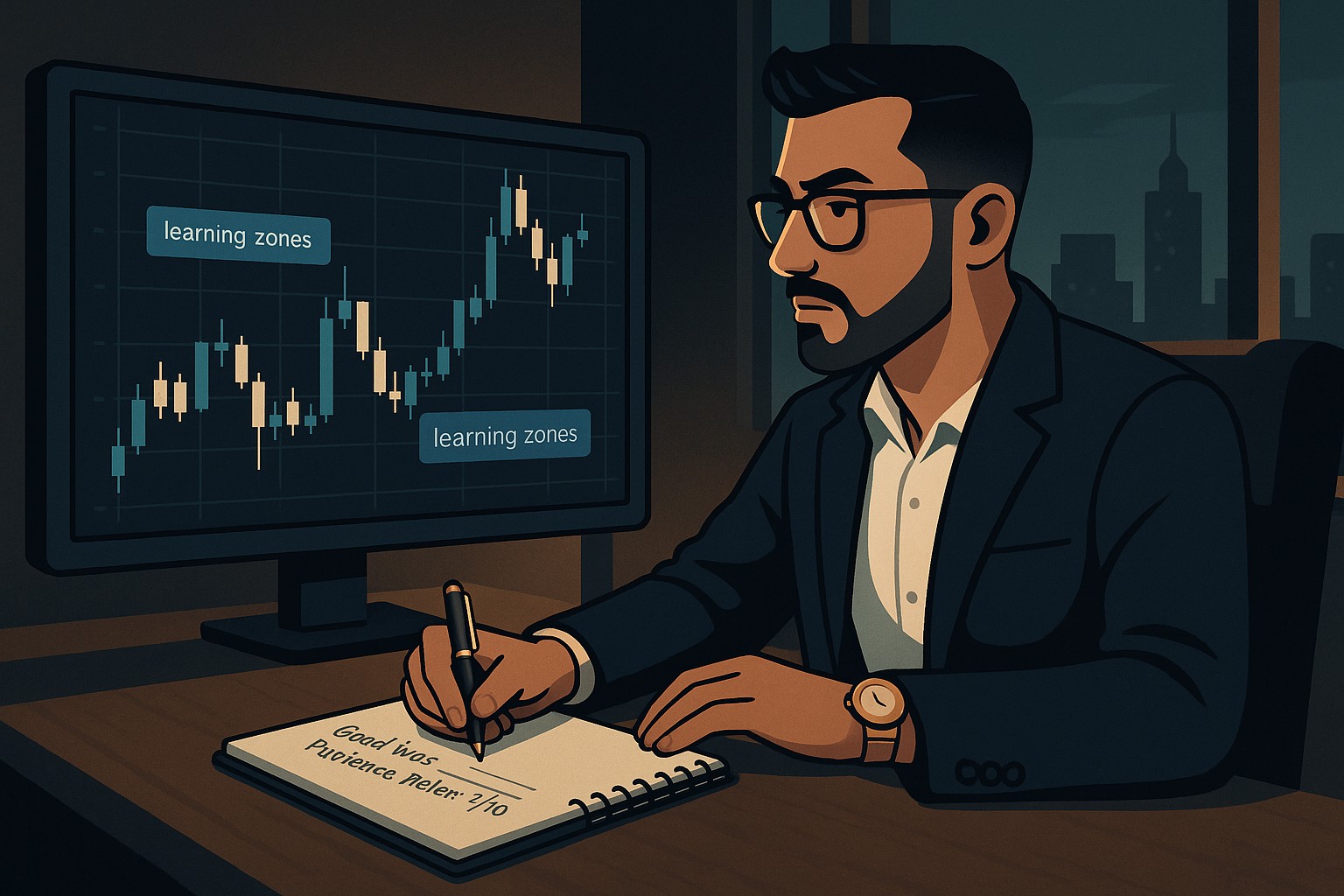Managing Imperfect Entries in Trading - How Professionals Stay Composed
2025-10-28 10:48:42
Every trader dreams of that perfect entry - precision timing, flawless confirmation, and price immediately reacting in their favor. But markets don’t reward perfectionism. They reward adaptability.

Even the most skilled traders face moments where the entry slips - spreads widen, liquidity thins, or a fast candle invalidates a setup by a tick.
Professional traders don’t panic when this happens. They don’t rage, chase, or flip direction impulsively. Instead, they activate what I call the Professional Recovery Protocol - a sequence of three actions: Reframe, Re-anchor, and Reposition.
In this feature, we’ll break down how to handle imperfect execution without emotional damage. Because mastery isn’t about always being right - it’s about staying composed when things go wrong. If you want a foundation for this, start with the mindset anchors in Execution Psychology and the Confirmation Matrix.
The Myth of the Perfect Entry

The idea of perfect execution is seductive. Traders think, “If only I had waited for confirmation,” or “If I’d entered one candle earlier, it would’ve worked.”
But here’s the truth: the market is never perfect. Even institutions experience slippage and partial fills. Algorithms adjust constantly because volatility shifts microstructure behavior every second.
So, if you expect every trade to trigger with surgical precision, you’ve set yourself up for chronic frustration.
Professionals embrace imperfection as part of the job. They understand that execution is probabilistic, not poetic. The difference is not in precision - it’s in response quality. That’s why they lean on multi-timeframe analysis to keep entries anchored to structure rather than emotion.
The Hidden Cost of Chasing Perfect Entries

Ironically, the search for perfect entries often causes the opposite problem: you never execute at all.
Traders spend hours filtering out setups, waiting for the mythical “A+ trade,” until the session ends and the opportunity is gone. Then, frustration kicks in - “I saw it, but didn’t take it.”
This happens because the brain associates “perfection” with “safety.” It’s an emotional defense mechanism - a way of avoiding the discomfort of uncertainty. But trading isn’t about eliminating uncertainty. It’s about managing it through structure and timely confirmations. Your model might call for a liquidity sweep followed by an MSS - when you see that sweep, understand why it happens and how to trade it instead of hesitating for a textbook-perfect candle.
Yes, we should aim for A+ setups, but professionals understand that adaptability is part of A+ execution. Adjusting to a slightly wider stop due to volatility, accepting a partial fill, or re-entering after a targeted revisit of a fair value gap - these aren’t compromises; they’re refinements.
The key is this:
“Adapt when necessary - not impulsively, not emotionally, but strategically.”
You’re not changing your entry model. You’re interpreting it dynamically.
Step 1: Reframe - Change the Meaning, Change the Impact
After a less-than-ideal entry, your first instinct might be frustration. You might replay the candle in your mind, zoom into the 1-minute chart, and blame yourself for missing a micro cue. But reframing means changing what it means.
Instead of thinking:
“I messed up again.”
Reframe it as:
“The setup structure was valid. Execution just needs refining.”
When you reframe, you detach your identity from the outcome. You turn the experience into data, not drama.
Reframing also builds emotional tolerance. Every imperfect entry becomes training for your nervous system - strengthening your composure under uncertainty. If you often freeze on the trigger, revisit the mental game of execution to rebuild confidence around pulling it.
Step 2: Re-anchor - Return to the Higher Framework
Imperfect entries often lure traders into tunnel vision. They zoom in too far - M1, even 15-second charts - hoping to regain control. But control isn’t found by zooming in; it’s found by zooming out.
Re-anchoring means reconnecting with your higher timeframe narrative - the context that guided your bias in the first place.
- What was the HTF trend?
- Was your entry aligned with the session liquidity model you trade, like the New York session playbook?
- Did your execution confirm the market structure shift, or did you jump the gun?
Professionals always re-anchor before re-engaging. They understand that context corrects emotion.
“If the market hasn’t invalidated the bias, the setup isn’t dead - just delayed.”
This principle is the heartbeat of resilience. You’re not starting over; you’re recalibrating.
Step 3: Reposition - Strategically, Not Emotionally
Repositioning is the stage where most traders fall into traps. Revenge trading happens when they try to “win back” what they lost. Professionals reposition only when structure revalidates - never out of emotional urgency.
Repositioning doesn’t mean re-entering immediately. Sometimes it means stepping away and letting the next liquidity event form. Sometimes it means taking a smaller size. But it always follows data, not dopamine.
Here’s a simple rule:
“If I can’t explain my re-entry in one logical sentence, it’s not valid yet.”
Examples:
- ✅ “Liquidity swept previous high; MSS confirmed; new M5 FVG formed.”
- ❌ “I just want to make back the loss.”
When your reason is logical, not emotional, your recovery trade becomes an edge, not a chase. For clarity on where to trigger, lean on your confirmation process so the market, not your feelings, gives the green light.
The Science Behind Recovery Speed

Neuroscience backs this up. When traders make a loss, the brain releases cortisol and dopamine balance tilts toward impulsivity. This fuels revenge trades. But if you pause - even 90 seconds of deep breathing - your prefrontal cortex regains control, restoring rational decision-making.
Top traders use physiological resets as part of their playbook:
- Step back from the screen.
- Deep belly breathing for 90 seconds.
- Journaling one neutral statement: “Data captured, emotion diffused.”
Pair that with a quick risk check before any re-entry. A concise risk management plan protects you from letting a small execution error grow into an outsized drawdown.
The Reframe Formula (R³ Protocol)
You can summarize the professional recovery sequence as the R³ Protocol:
| Step | Action | Focus |
|---|---|---|
| Reframe | Change the meaning of the loss | “It’s feedback, not failure.” |
| Re-anchor | Return to the HTF context | “Am I still aligned with my plan?” |
| Reposition | Act logically, not emotionally | “If structure confirms, I’ll re-engage.” |
You can also integrate this into your SMC workflow. If you trade indices at the open, imperfect fills are common around volatility bursts - your job is to let the sweep and the fair value gap confirm the reclaim, not to force a second-click. If you prefer metals, revisit the day trading gold guide for clean re-entry structures after a stop-out.
Real-Life Analogy: The Pilot’s Missed Landing
Think of a professional pilot approaching an airport. Crosswinds hit. He’s slightly off-center. Instead of forcing the landing, he goes around. He doesn’t see it as failure - just a standard maneuver.
That’s exactly how a professional trader treats imperfect entries. Reframe the “go-around” not as fear, but as precision discipline. Because safety - and profitability - often come from restraint. On days when sentiment shifts fast, zoom out and reassess the backdrop using risk-on and risk-off cues before deciding whether the setup is still valid.
Final Thoughts

Trading isn’t about flawless timing. It’s about flawless composure. The professionals you admire don’t execute perfectly - they recover perfectly.
When you stop expecting perfection, you stop fearing imperfection. That’s when consistency begins.
So next time you’re tempted to wait for the “perfect” entry, remember - perfect is often the reason you never execute at all. The goal isn’t perfection. The goal is professionalism - the ability to adapt when necessary, stay loyal to your model, and act with calm confidence even when the market gets messy.
Start Practicing with Confidence - Risk-Free!
- Trade forex, indices, gold, and more
- Access ACY, MT4, MT5, & Copy Trading Platforms
- Practice with zero risk
It’s time to go from theory to execution - risk-free.
Create an Account. Start Your Free Demo!
Check Out My Contents:
Strategies That You Can Use
Looking for step-by-step approaches you can plug straight into the charts? Start here:
- How To Trade & Scalp Indices at the Open Using Smart Money Concepts (SMC)
- How to Trade Breakouts Effectively in Day Trading with Smart Money Concepts
- Complete Step-by-Step Guide to Day Trading Gold (XAU/USD) with Smart Money Concepts (SMC)
- The Power of Multi-Timeframe Analysis in Smart Money Concepts (SMC)
- Forex Trading Strategy for Beginners
- Mastering Candlestick Pattern Analysis with the SMC Strategy for Day Trading
- How to Use Fibonacci to Set Targets & Stops (Complete Guide)
- RSI Divergence Trading Strategy for Gold: How to Identify and Trade Trend Reversals
- Stochastics Trading Secrets: How to Time Entries in Trending Markets using Stochastics
- Gold Trading Stochastics Strategy: How to Trade Gold with 2R - 3R Targets
- RSI Hidden Divergence Explained: How to Spot Trend Continuations Like a Pro
- Moving Averages Trading Strategy Playbook
- Mastering Fibonacci Trading Psychology - Trusting the Levels, Managing the Mind
- Mastering Price Action at Key Levels - How to Spot, Trade, and Win at the Most Crucial Zones
- Mastering Retests: How to Enter with Confirmation After a Breakout
Indicators / Tools for Trading
Sharpen your edge with proven tools and frameworks:
- The Ultimate Guide to Risk Management in Trading - A Complete Compilation for 2025
- Moving Averages Trading Strategy Playbook
- How to Think Like a Price Action Trader
- Mastering Fibonacci Trading Psychology - Trusting the Levels, Managing the Mind
How To Trade News
News moves markets fast. Learn how to keep pace with SMC-based playbooks:
- Why Smart Money Concepts Work in News-Driven Markets - CPI, NFP, and More
- How to Trade NFP Using Smart Money Concepts (SMC) - A Proven Strategy for Forex Traders
- How to Trade CPI Like Smart Money - A Step-by-Step Guide Using SMC
Learn How to Trade US Indices
From NASDAQ opens to DAX trends, here’s how to approach indices like a pro:
- How to Start Trading Indices and Get into the Stock Market with Low Capital (2025 Guide)
- Best Indices to Trade for Day Traders | NASDAQ, S&P 500, DAX + Best Times to Trade Them
- How To Trade & Scalp Indices at the Open Using Smart Money Concepts (SMC)
- NAS100 - How to Trade the Nasdaq Like a Pro (Smart Money Edition)
How to Start Trading Gold
Gold remains one of the most traded assets - here’s how to approach it with confidence:
- How to Swing Trade Gold (XAU/USD) Using Smart Money Concepts: A Simple Guide for Traders
- Complete Step-by-Step Guide to Day Trading Gold (XAU/USD) with Smart Money Concepts (SMC)
- The Ultimate Guide to Backtesting and Trading Gold (XAU/USD) Using Smart Money Concepts (SMC)
- Why Gold Remains the Ultimate Security in a Shifting World
- How to Exit & Take Profits in Trading Gold Like a Pro: Using RSI, Range Breakdowns, and MAs as Your Confluence
How to Trade Japanese Candlesticks
Candlesticks are the building blocks of price action. Master the most powerful ones:
- Mastering the Top Japanese Candlesticks: The Top 5 Candlesticks To Trade + Top SMC Candlestick Pattern
- How to Trade Candlestick Patterns with High Probability: A Complete Guide for Beginners
- The Top Japanese Candlestick Guide: What is an Engulfing Pattern and How to Trade It?
- Piercing Pattern Candlestick Explained: How to Trade It - Step-By-Step Guide
- Morning & Evening Star Candlestick Patterns - How to Trade Market Reversals with Confidence
How to Start Day Trading
Ready to go intraday? Here’s how to build consistency step by step:
- 5 Steps to Start Day Trading: A Strategic Guide for Beginners
- 8 Steps How to Start Forex Day Trading in 2025: A Beginner’s Step-by-Step Guide
- 3 Steps to Build a Trading Routine for Consistency and Discipline - Day Trading Edition
- The Ultimate Guide to Understanding Market Trends and Price Action
- Trading with Momentum: The Best Trading Session to Trade Forex, Gold and Indices
Swing Trading 101
- Introduction to Swing Trading
- The Market Basics for Swing Trading
- Core Principles of Swing Trading
- The Technical Foundations Every Swing Trader Must Master
- Swing Trader’s Toolkit: Multi-Timeframe & Institutional Confluence
- The Psychology of Risk Management in Swing Trading
- Swing Trading Concepts To Know In Trading with Smart Money Concepts
- Becoming a Consistent Swing Trader: Trading Structure & Scaling Strategy
Learn how to navigate yourself in times of turmoil
Markets swing between calm and chaos. Learn to read risk-on vs risk-off like a pro:
- How to Identify Risk-On and Risk-Off Market Sentiment: A Complete Trader’s Guide
- How to Trade Risk-On and Risk-Off Sentiment - With Technical Confirmation
- The Ultimate Guide to Understanding Market Trends and Price Action
- Metals in Risk-On and Risk-Off Environments: How Sentiment Moves Gold and Commodities
Want to learn how to trade like the Smart Money?
Step inside the playbook of institutional traders with SMC concepts explained:
- Why Smart Money Concepts Work: The Truth Behind Liquidity and Price Action
- Mastering the Market with Smart Money Concepts: 5 Strategic Approaches
- Understanding Liquidity Sweep: How Smart Money Trades Liquidity Zones in Forex, Gold, US Indices
- The SMC Playbook Series Part 1: What Moves the Markets? Key Drivers Behind Forex, Gold & Stock Indices
- The SMC Playbook Series Part 2: How to Spot Liquidity Pools in Trading - Internal vs External Liquidity Explained
- Fair Value Gaps Explained: How Smart Money Leaves Footprints in the Market
- Accumulation, Manipulation, Distribution: The Hidden Cycle That Runs Every Market
- Institutional Order Flow - Reading the Market Through the Eyes of the Big Players
- London Session Trading Secrets: How Smart Money Sets the High & Low of the Day
- Mastering the New York Session - Smart Money Concepts Guide
- Anatomy of a Perfect Execution: How SMC Traders Trade with Precision
- Step-by-Step Trading Confirmation Guide for Precise Execution
- Execution Psychology: Turning Hesitation into Confidence
Master the World’s Most Popular Forex Pairs
Forex pairs aren’t created equal - some are stable, some are volatile, others tied to commodities or sessions.
- The Top 5 All-Time Best Forex Pairs to Trade
- Top Forex Pairs Beyond the Big Five
- EUR/USD: The King of Forex
- USD/JPY: The Fast Mover
- GBP/USD: The Volatile Cable
- AUD/USD: The Commodity Currency
- USD/CAD: The Oil-Backed Pair
- GBP/JPY: How to Trade The Beast
- Asian & London Session Secrets
- Mastering the New York Session
Metals Trading
- Metals Trading: Why Gold and Metals Are Rising Again
- Silver Trading: The Underdog with Dual Identity
- Gold vs Silver: Institutional Demand Breakdown Explained
- Platinum & Palladium: The Quiet Power Duo of Industrial Metals
- How to Trade Metals with SMC and Fundamentals - Gold Trading Strategy
- Future of Metals Market: Gold Forecast 2026 & Long-Term Commodities Outlook
Stop Hunting 101
If you’ve ever been stopped out right before the market reverses - this is why:
- Stop Hunting 101: How Swing Highs and Lows Become Liquidity Traps
- Outsmarting Stop Hunts: The Psychology Behind the Trap
- How to Lessen Risk From Stop Hunts in Trading
- How Stop Hunts Trigger Revenge Trading - Breaking the Pain Cycle
- How to Accept Stop Hunts Without Losing Discipline - Shifting From Frustration to Focus
Trading Psychology
Mindset is the deciding factor between growth and blowups. Explore these essentials:
- The Mental Game of Execution - Debunking the Common Trading Psychology
- Managing Trading Losses: Why You Can Be Wrong and Still Win Big in Trading
- The Hidden Threat in Trading: How Performance Anxiety Sabotages Your Edge
- Why 90% of Retail Traders Fail Even with Profitable Trading Strategies
- Top 10 Habits Profitable Traders Follow Daily to Stay Consistent
- Top 10 Trading Rules of the Most Successful Traders
- Top 10 Ways to Prevent Emotional Trading and Stay Disciplined in the Markets
- Why Most Traders Fail - Trading Psychology & The Hidden Mental Game
- Emotional Awareness in Trading - Naming Your Triggers
- Discipline vs. Impulse in Trading - Step-by Step Guide How to Build Control
- Trading Journal & Reflection - The Trader’s Mirror
- Overcoming FOMO & Revenge Trading in Forex - Why Patience Pays
- Risk of Ruin in Trading - Respect the Math of Survival
- Identity-Based Trading: Become Your Trading System for Consistency
- Trading Psychology: Aligning Emotions with Your System
- Mastering Fear in Trading: Turn Doubt into a Protective Signal
- Mastering Greed in Trading: Turn Ambition into Controlled Growth
- Mastering Boredom in Trading: From Restless Clicking to Patient Precision
- Mastering Doubt in Trading: Building Confidence Through Backtesting and Pattern Recognition
- Mastering Impatience in Trading: Turn Patience Into Profit
- Mastering Frustration in Trading: Turning Losses Into Lessons
- Mastering Hope in Trading: Replacing Denial With Discipline
- When to Quit on Trading - Read This!
- The Math of Compounding in Trading
- Why Daily Wins Matter More Than Big Wins
- Scaling in Trading: When & How to Increase Lot Sizes
- Why Patience in Trading Fuels the Compounding Growth
- Step-by-Step Guide on How to Manage Losses for Compounding Growth
- The Daily Habits of Profitable Traders: Building Your Compounding Routine
- Trading Edge: Definition, Misconceptions & Casino Analogy
- Finding Your Edge: From Chaos to Clarity
- Proving Your Edge: Backtesting Without Bias
- Forward Testing in Trading: How to Prove Your Edge Live
- Measuring Your Edge: Metrics That Matter
- Refining Your Edge: Iteration Without Overfitting
- The EDGE Framework: Knowing When and How to Evolve as a Trader
- Scaling Your Edge: From Small Account to Consistency
Market Drivers
- Central Banks and Interest Rates: How They Move Your Trades
- Inflation & Economic Data: CPI Trading Strategy and PPI Indicator Guide
- Geopolitical Risks & Safe Havens in Trading (Gold, USD, JPY, CHF)
- Jobs, Growth & Recession Fears: NFP, GDP & Unemployment in Trading
- Commodities & Global Trade: Oil, Gold, and Forex Explained
- Market Correlations & Intermarket Analysis for Traders
Risk Management
The real edge in trading isn’t strategy - it’s how you protect your capital:
- Mastering Risk Management: Stop Loss, Take Profit, and Position Sizing
- Why Risk Management Is the Only Edge That Lasts
- How Much Should You Risk per Trade? (1%, 2%, or Less?)
- The Ultimate Risk Management Plan for Prop Firm Traders - Updated 2025
- Mastering Position Sizing: Automate or Calculate Your Risk Like a Pro
- Martingale Strategy in Trading: Compounding Power or Double-Edged Sword?
- How to Add to Winners Using Cost Averaging and Martingale Principle with Price Confirmation
Suggested Learning Path
If you’re not sure where to start, follow this roadmap:
- Start with Trading Psychology → Build the mindset first.
- Move into Risk Management → Learn how to protect capital.
- Explore Strategies & Tools → Candlesticks, Fibonacci, MAs, Indicators.
- Apply to Assets → Gold, Indices, Forex sessions.
- Advance to Smart Money Concepts (SMC) → Learn how institutions trade.
- Specialize → Stop Hunts, News Trading, Turmoil Navigation.
This way, you’ll grow from foundation → application → mastery, instead of jumping around randomly.
Follow me for more daily market insights!
Jasper Osita - LinkedIn - FXStreet - YouTube
This content may have been written by a third party. ACY makes no representation or warranty and assumes no liability as to the accuracy or completeness of the information provided, nor any loss arising from any investment based on a recommendation, forecast or other information supplies by any third-party. This content is information only, and does not constitute financial, investment or other advice on which you can rely.
Try These Next
4 Powerful Tactics to Overcome the Most Costly Forex Mistakes
How to Master MT4 & MT5 - Tips and Tricks for Traders
The Importance of Fundamental Analysis in Forex Trading
Forex Leverage Explained: Mastering Forex Leverage in Trading & Controlling Margin
The Importance of Liquidity in Forex: A Beginner's Guide
Close All Metatrader Script: Maximise Your Trading Efficiency and Reduce Stress
Best Currency Pairs To Trade in 2025
Forex Trading Hours: Finding the Best Times to Trade FX
MetaTrader Expert Advisor - The Benefits of Algorithmic Trading and Forex EAs
Top 5 Candlestick Trading Formations Every Trader Must Know















